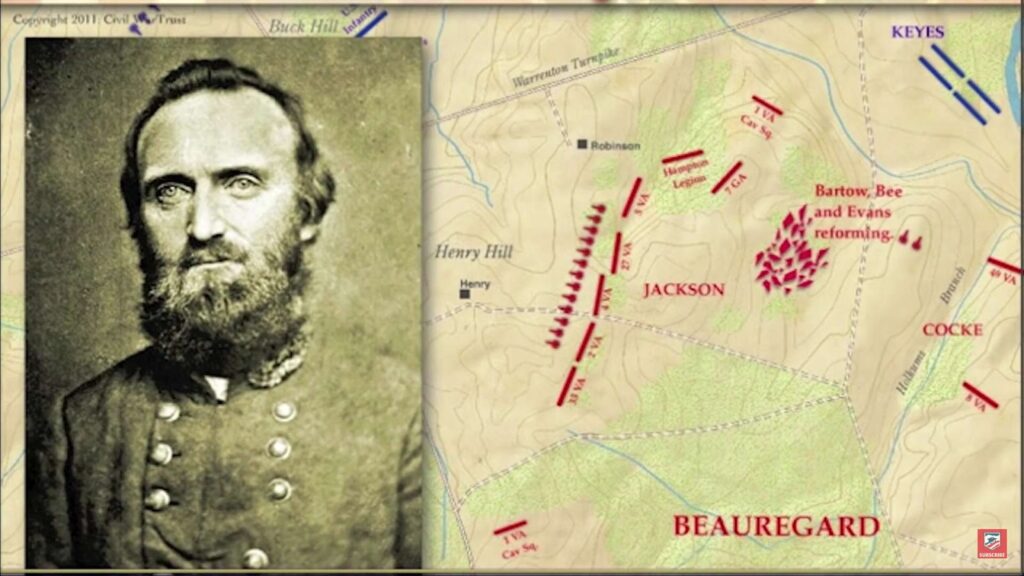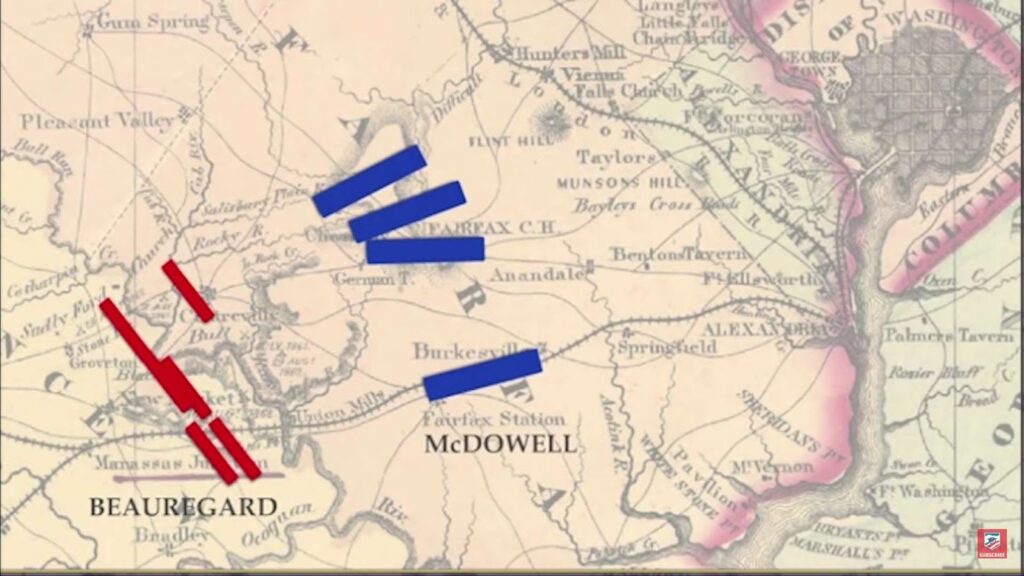Tucked away in Prince William County of Northern Virginia lies the Manassas National Battlefield Park. This sacred site stands as a testament to two crucial battles of the American Civil War: the famous Battle of First Manassas, also known as the First Battle of Bull Run, and the significant Battle of Second Manassas, or the Second Battle of Bull Run.
Attracting over 700,000 history aficionados annually, this landmark is dotted with a wealth of intriguing historical spots, all overshadowed by the striking Henry Hill Visitor Center. This center serves as a treasure trove of information, focusing primarily on the Battle of First Manassas. It provides an immersive experience into the depths of American history.
A Closer Look at the Battle of First Manassas
Considered one of the most significant battles of the American Civil War, the Battle of First Manassas (also known as the First Battle of Bull Run) was the war’s inaugural major land confrontation.
Just three months after the Fort Sumter bombardment occurred, the Union forces anticipated an easy victory over the Confederate armies due to their perceived military superiority. This conviction was also shared by the general public in the north, stirring up a prevalent expectation that the Union Army would promptly advance to Richmond, Virginia, the heart of the Confederacy. However, this over-enthusiasm soon turned out to be a miscalculation.
In July 1861, Brigadier General Irvin McDowell commanded an army of approximately 36,000 green Union soldiers to Manassas Junction, with a strategy of ambushing Brigadier General P. G. T. Beauregard’s Confederate Army. Despite their numerical advantage, things did not go as planned.
General Beauregard, having been tipped off about the impending Union assault, had assembled a group of about 20,000 troops. This force was soon bolstered by an additional 9,000 reinforcement troops under the command of General Joseph Johnston.
As the battle unfolded, several key factors became apparent:
- The scale and intensity of the battle was far beyond what either side had anticipated;
- The Union forces, despite their numerical advantage, were not prepared for the resilience of the Confederate troops;
- The unexpected arrival of reinforcements from Johnston’s men turned the tide in favor of the Confederates.
Consequently, the Battle of First Manassas proved a pivotal moment in the American Civil War, demonstrating that the conflict would be neither quick nor easy. Despite the North’s initial confidence, the South had shown they were a force to be reckoned with.
Subsequent to the Battle of First Manassas, both sides began to realize the need for better training and preparation, marking an important turning point in the strategic approach to the war. Read about stepping back in time and discover the captivating stories behind the Richmond VA Battlefield, where history comes alive!
The Unfolding of the First Major Land Battle of the Civil War
Dawn of July 21 brought with it the anticipation and unease that often precedes decisive historical moments. The North and South’s face-off had attracted expectant spectators who gathered in numbers to see the first major land battle of the Civil War, unaware of the intensity that was to unfold.
As the battle commenced, a contingent of Union regiments ventured across the narrow Bull Run tributary. This action marked the beginning of a series of intense confrontations that saw Confederate troops initially retreating to Henry House Hill.
Little did the Union Army know, Henry House Hill was, in fact, a strategic stronghold for the Confederates. The Virginia Brigade was awaiting their arrival, commanded by the formidable General Thomas J. Jackson. Cleverly shielded on the rear side of the hill, they had created a natural fortification that allowed them to effectively diminish the Union Army’s advancing threat.
- It was during this heated exchange on the hillside that Jackson earned his famous nickname “Stonewall,” a testament to his unwavering resilience and strategic prowess;
- This brave stand cemented “Stonewall” Jackson’s place in military history as a symbol of resolute resistance.
Adding to the Confederates’ successful defensive strategy was the fierce charge led by their cavalry under the leadership of J.E.B. Stuart. This aggressive move not only disoriented the Union flank but also led to the capture of their artillery, giving the Confederates a significant advantage.
The pressure mounted on McDowell’s troops, and they soon found themselves in retreat. A once orderly and confident Union army now found itself scampering haphazardly back across the Bull Run in a disheveled retreat. This stark transformation in such a short time frame served as a stark reminder of the unpredictability of war and the power of strategic maneuvering.
The Aftermath and Reflection: A Glimpse into the Harsh Realities of War
The Battle of First Manassas, though by far not the most catastrophic in terms of casualties during the Civil War, nonetheless etched an indelible mark on the collective psyche of both the Union and Confederate armies. With around 60,000 soldiers present on the battlefield that day, the clash served as a grim preview of the industrial-scale warfare that was to unfold in the coming years.

Though less than two-thirds of the soldiers on both sides were engaged in active combat, the post-battle statistics were shocking. As the dust settled, almost 1,000 men laid dead on the fields of Manassas, with approximately 2,500 more left wounded. These casualty figures were unprecedented at the time, casting a somber mood across both North and South:
- For the Union, the defeat was a bitter pill to swallow. The North began to understand that their road to victory would be much more complex than initially thought. This realization led to an increase in efforts to improve military training, strategizing, and discipline among the Union troops;
- The Confederates, victorious but scarred by the loss of their comrades, also learned a valuable lesson. Their victory, though important for morale, had come at a high cost. As eloquently put by the Confederate President Jefferson Davis, “We have won a glorious but dear-bought victory.”
The Battle of First Manassas served as a sobering reminder of the high stakes and cruel realities of war. Both governments, shocked by the bloodshed, started taking measures to prepare for the fierce and devastating struggles that lay ahead. The rest of the country was forced to face the reality that the war, far from being a quick skirmish, was likely to be a long and drawn-out affair with serious human costs.
Manassas Battlefield: Echoes from the Past
A visit to the Manassas Battlefield offers a wealth of experiences that bring to life the events surrounding the Battle of First Manassas. Here, the visitor gets to tread on the same ground where thousands of men fought and died for their beliefs. Various notable sites allow visitors to immerse themselves into different aspects of the Civil War experience:
- “Manassas: End of Innocence” Documentary: Housed within the Visitor Center, this beautifully crafted film dives deep into the personal accounts of those who witnessed the battle. It offers an invaluable perspective on how soldiers and civilians alike would have perceived the unfolding events;
- The Henry Hill Visitor Center: This site allows visitors to connect with the personal narratives of the men and women involved in the battle. Displaying a collection of artifacts, it provides a powerful means to better understand the daily lives and struggles of those living through the Civil War era;
- Henry House: This historic structure is a poignant reminder of the civilian toll of war. Once the dwelling of Judith Henry, the only civilian casualty at the first Battle of Manassas, it now stands as a silent testament to the indiscriminate destructiveness of warfare;
- Stone House: This resilient structure served as a makeshift hospital during both the First and Second Manassas battles. It’s a touching reminder of the relentless efforts of medics striving to save and prolong lives amidst the brutalities of war;
- Matthews Hill: Known for its strategic importance during the first Battle of Manassas, this hill was the birthplace of several decisive moments that changed the course of the battle;
- Stonewall Jackson Monument: Pay homage to the legendary General at the bronze statue erected in his honor on Henry Hill. The monument serves as a focal point for understanding the role of key individuals in deciding the fate of the battle.
Each of these key landmarks offers a unique window into the First Manassas Battle, creating a comprehensive and captivating narrative surrounding one of the most formative events in American history.
Conclusion
To sum up, the Manassas National Battlefield Park serves as a powerful symbol of the bravery and selflessness observed in the American Civil War. Located in Prince William County, Northern Virginia, this hallowed ground resonates with the lingering reverberations of two significant conflicts: the First and Second Battles of Manassas. The park, enriched by its profound historical importance and augmented by the engaging exhibits at the Henry Hill Visitor Center, draws in excess of 700,000 visitors each year. This enduring interest guarantees that the legacy of these crucial junctures in American history will be preserved for future generations.
